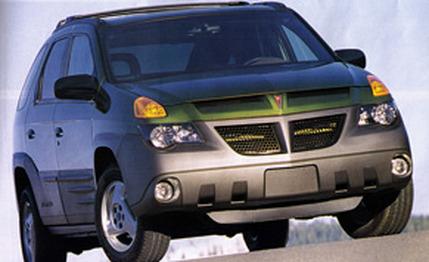 First Drive Review
First Drive Review
Okay, knock off the jokes, and try to look past the wrapper here. Yeah, yeah, we know that's not easy, but these people are serious about this thing, and anyway, the rules are changing. The Chrysler PT Cruiser proved that. And no, we don't think it looks like an inflatable toy. At least not very much.
Pontiac's marketing troops do appear to share at least some awareness that this vehicle's design is, well, polarizing, although we wonder if that awareness is as acute as it ought to be. Then again, if it were, the Aztek might never have made it into production, at least not in the form we see here. Some perceive this SRV (for "sport recreation vehicle") as an extreme expression of post-millennium Pontiac moderne, with otherworldly lines and proportions added to the division's peculiar preoccupation with plastic body cladding. But that may sound harsh. So let's all try to agree on "unique" and move on.
Fine. Under its . . . unique . . . exterior, the Aztek is a minivan, with the same basic bones as the short-version Chevy Venture, Oldsmobile Silhouette, and Pontiac Montana, albeit some four inches shorter in wheelbase. In this iteration, the platform has been bolstered by the addition of a hydroformed engine cradle, and come January it will also offer the option of a brand-new all-wheel-drive system. GM calls it Versatrak, a fully automatic setup that starts feeding power to the rear wheels when there's slippage up front -- no switches, no shifters, no transfer case. Versatrak uses no center or rear differential. Instead, a pair of gerotor pumps and multiplate clutch packs on the rear axle put either or both rear wheels to work whenever there is slippage at the front axle. The twin gerotor setup acts like a limited-slip rear differential, so it can also handle split-mu traction situations -- better adhesion on one side of the vehicle than on the other -- and Pontiac claims it can keep the Aztek moving even when only one rear wheel has grip. The Versatrak system will be used by the upcoming Buick Rendezvous, another minivan-based creation with a more traditional sport-utility look, and eventually GM plans to offer it in the minivans, too.
Although we were unable to drive a Versatrak Aztek during our first hands-on experience with this vehicle, which entailed a day of putting a lap on Lake Tahoe, we did get to see the system in action on a Squaw Valley ice rink. There the 4050-pound Aztek dragged a 3200-pound Honda CR-V backward kicking and screaming across the ice, which proved something, we suppose -- maybe that it was time for dinner.
Aside from the Versatrak option, the powertrain is otherwise straight from the minivan lineup -- GM's 3400 pushrod V-6 (185 horsepower and 210 pound-feet of torque) driving the front wheels through a typically smooth GM four-speed automatic transmission. The front suspension is similar to the strut setup used on the minivans, with a bit of tweaking that expands the front track from the Montana minivan's 61.5 inches to 62.7 inches. The rear wheels are supported by an ordinary twist-beam axle (although Versatrak models will get a much more sophisticated independent system), and the track back there is even wider at 63.8 inches. Wider, in fact, than traditional sport-utilities like the Dodge Durango and Ford Explorer. Wide track, of course, is a historic Pontiac mantra, resurrected with the latest redesign of the Grand Prix, a car the division invokes in establishing an image for its newcomer: "From the Grand Prix sports sedan, the Aztek draws instantly recognizable Pontiac design cues, a wide-track stance for sporty ride and handling . . ." We pass that along in case the Grand Prix influence isn't quite as instantly recognizable as these guys think.
Stopping power is provided by a disc-and-drum setup with a Bosch 5.3 four-channel anti-lock system. Four-wheel-drive models have four-wheel discs. Steering is power rack and pinion, and there are three wheel-and-tire packages: a base 215/70SR-15 on a steel wheel, a 215/65SR-16 for Versatrak and GT models, and an optional 215/70SR-16 white-letter tire for the GT. All are all-season tires, and the best that can be said for their dry-performance capabilities is that it takes medium-serious abuse to get them to squeal for mercy.